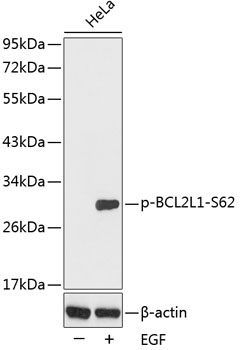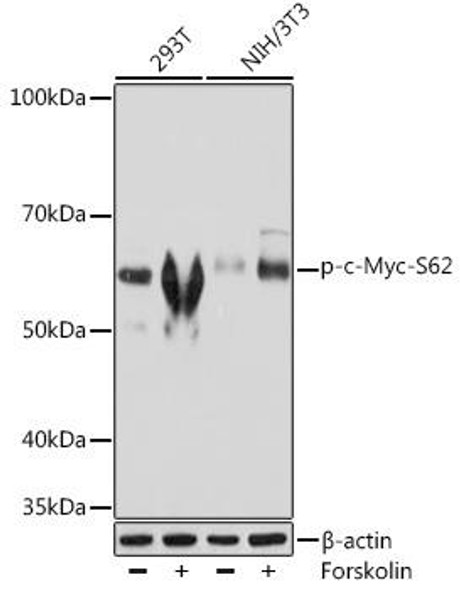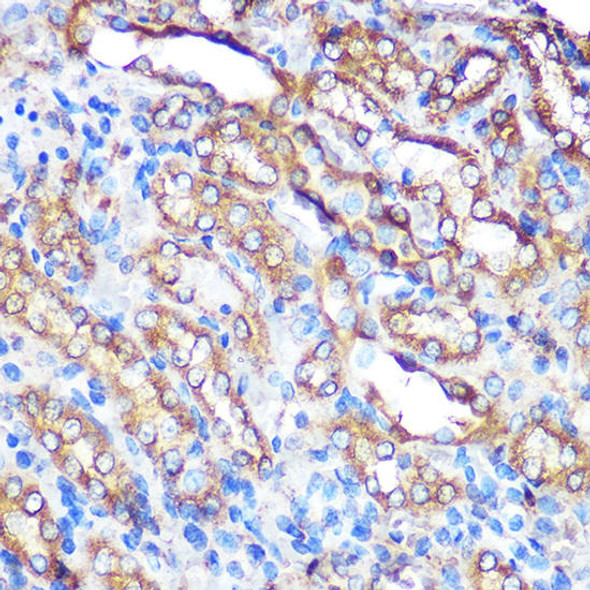Cell Death Antibodies 2
Anti-Phospho-BCL2L1-S62 Antibody (CABP0314)
- SKU:
- CABP0314
- Product Type:
- Antibody
- Applications:
- WB
- Applications:
- IHC
- Applications:
- IF
- Reactivity:
- Human
- Reactivity:
- Mouse
- Reactivity:
- Rat
- Host Species:
- Rabbit
- Isotype:
- IgG
- Research Area:
- Cell Death
Description
| Antibody Name: | Anti-Phospho-BCL2L1-S62 Antibody |
| Antibody SKU: | CABP0314 |
| Antibody Size: | 50uL, 100uL |
| Application: | WB IHC IF |
| Reactivity: | Human, Mouse, Rat |
| Host Species: | Rabbit |
| Immunogen: | A phospho specific peptide corresponding to residues surrounding S62 of human BCL2L1 |
| Application: | WB IHC IF |
| Recommended Dilution: | WB 1:500 - 1:2000 IHC 1:50 - 1:100 IF 1:50 - 1:100 |
| Reactivity: | Human, Mouse, Rat |
| Positive Samples: | HeLa |
| Immunogen: | A phospho specific peptide corresponding to residues surrounding S62 of human BCL2L1 |
| Purification Method: | Affinity purification |
| Storage Buffer: | Store at -20°C. Avoid freeze / thaw cycles. Buffer: PBS with 0.02% sodium azide, 50% glycerol, pH7.3. |
| Isotype: | IgG |
| Sequence: | Email for sequence |
| Gene ID: | 598 |
| Uniprot: | Q07817 |
| Cellular Location: | Cytoplasm, Cytoplasmic side, Cytoplasmic vesicle, Mitochondrion inner membrane, Mitochondrion matrix, Mitochondrion outer membrane, Nucleus membrane, Single-pass membrane protein, centrosome, cytoskeleton, cytosol, microtubule organizing center, secretory vesicle, synaptic vesicle membrane |
| Calculated MW: | 18kDa/25-26kDa |
| Observed MW: | 30kDa |
| Synonyms: | BCL2L1, BCL-XL/S, BCL2L, BCLX, Bcl-X, PPP1R52, BCL2 like 1, Bcl-XL |
| Background: | The protein encoded by this gene belongs to the BCL-2 protein family. BCL-2 family members form hetero- or homodimers and act as anti- or pro-apoptotic regulators that are involved in a wide variety of cellular activities. The proteins encoded by this gene are located at the outer mitochondrial membrane, and have been shown to regulate outer mitochondrial membrane channel (VDAC) opening. VDAC regulates mitochondrial membrane potential, and thus controls the production of reactive oxygen species and release of cytochrome C by mitochondria, both of which are the potent inducers of cell apoptosis. Alternative splicing results in multiple transcript variants encoding two different isoforms. The longer isoform acts as an apoptotic inhibitor and the shorter isoform acts as an apoptotic activator. |
| UniProt Protein Function: | Bcl-xL: an antiapoptotic member of the Bcl-2 family. Located at the outer mitochondrial membrane and regulates outer mitochondrial membrane channel (VDAC) opening. VDAC regulates mitochondrial membrane potential, and thus controls the production of reactive oxygen species and release of cytochrome C by mitochondria, both of which are potent inducers of cell apoptosis. Two alternatively spliced isoforms have been reported. |
| UniProt Protein Details: | Protein type:Mitochondrial; Autophagy; Apoptosis; Membrane protein, integral Chromosomal Location of Human Ortholog: 20q11.21 Cellular Component: cell junction; centrosome; cytoplasm; cytosol; integral to membrane; mitochondrial inner membrane; mitochondrial matrix; mitochondrial outer membrane; mitochondrion; nuclear membrane; synaptic vesicle membrane Molecular Function:BH3 domain binding; identical protein binding; protein binding; protein heterodimerization activity; protein homodimerization activity; protein kinase binding Biological Process: apoptotic mitochondrial changes; cell proliferation; cellular process regulating host cell cycle in response to virus; cytokinesis; DNA damage response, signal transduction resulting in induction of apoptosis; endocytosis; fertilization; germ cell development; growth; in utero embryonic development; male gonad development; mitotic cell cycle checkpoint; negative regulation of apoptosis; negative regulation of autophagy; negative regulation of neuron apoptosis; neuron apoptosis; ovarian follicle development; positive regulation of cell proliferation; regulation of mitochondrial membrane permeability; regulation of mitochondrial membrane potential; release of cytochrome c from mitochondria; response to cycloheximide; response to cytokine stimulus; spermatogenesis; suppression by virus of host apoptosis |
| NCBI Summary: | The protein encoded by this gene belongs to the BCL-2 protein family. BCL-2 family members form hetero- or homodimers and act as anti- or pro-apoptotic regulators that are involved in a wide variety of cellular activities. The proteins encoded by this gene are located at the outer mitochondrial membrane, and have been shown to regulate outer mitochondrial membrane channel (VDAC) opening. VDAC regulates mitochondrial membrane potential, and thus controls the production of reactive oxygen species and release of cytochrome C by mitochondria, both of which are the potent inducers of cell apoptosis. Alternative splicing results in multiple transcript variants encoding two different isoforms. The longer isoform acts as an apoptotic inhibitor and the shorter isoform acts as an apoptotic activator. [provided by RefSeq, Dec 2015] |
| UniProt Code: | Q07817 |
| NCBI GenInfo Identifier: | 728955 |
| NCBI Gene ID: | 598 |
| NCBI Accession: | Q07817.1 |
| UniProt Secondary Accession: | Q07817,Q5CZ89, Q5TE65, Q92976, E1P5L6, |
| UniProt Related Accession: | Q07817 |
| Molecular Weight: | 25,290 Da |
| NCBI Full Name: | Bcl-2-like protein 1 |
| NCBI Synonym Full Names: | BCL2 like 1 |
| NCBI Official Symbol: | BCL2L1 |
| NCBI Official Synonym Symbols: | BCLX; BCL2L; Bcl-X; PPP1R52; BCL-XL/S |
| NCBI Protein Information: | bcl-2-like protein 1 |
| UniProt Protein Name: | Bcl-2-like protein 1 |
| UniProt Synonym Protein Names: | Apoptosis regulator Bcl-X |
| UniProt Gene Name: | BCL2L1 |
| UniProt Entry Name: | B2CL1_HUMAN |







